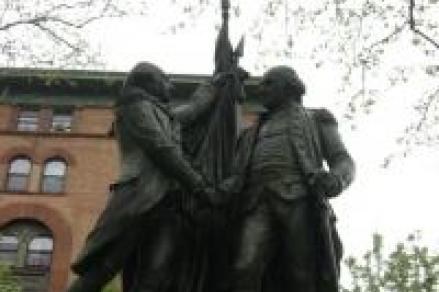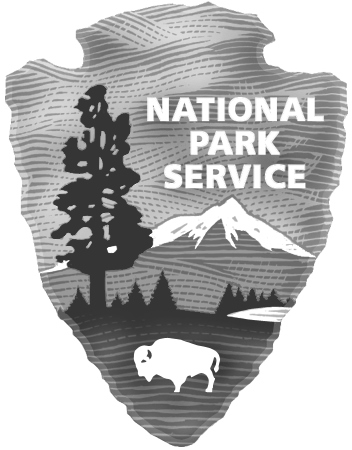In this jig-saw activity, students work with a variety of primary sources to learn the story behind a monument. Along the way, they learn about the history of General Lafayette's experience in and influence over the fledging nation as well as about the creation of the monument about 75 years later.
Historical Case Study: Lafayette Square
Historical Case Study: Lafayette Square

Location
Type of Landmark
Learning Objectives
- Students will be able to use primary source evidence to describe Lafayette’s motivations for coming to America, the relationship between Gen. Washington and Gen. Lafayette, and American attitudes toward Lafayette (as demonstrated during his 1824-5 tour of the US).
- Students will be able to use primary source documents to perform a historical investigation of the local landmark, Washington & Lafayette.
- Students will be able to reflect on the meaning of Washington & Lafayette as it exists in its current and historical contexts based on their investigation.
Materials
Photographs of Lafayette Square, New York, New York:
Image 1, Image 2, Image 3, Image 4, Image 5, Image 6, Image 7, Image 8, Image 9, Image 10. by Rachel Wilson, 2015.
New York City Department of Parks and Recreation. Lafayette Square. c2005. Photographs. New York.
First set of primary sources:
Washington, George. “Letter to Marie Joseph Paul Yves Roch Gilbert du Motier, Marquis de Lafayette, 8 May 1790.” 1790. MS. University of Virginia. Web. 31 Jul. 2015. Excerpts.
Washington, George. ““Letter to Marie Joseph Paul Yves Roch Gilbert du Motier, Marquis de Lafayette, February 01, 1784.” 1784. MS. Ashbrook Center at Ashland University.
Washington, George. “Letter to Marie Joseph Paul Yves Roch Gilbert du Motier, Marquis de Lafayette, December 25, 1798.” 1798. MS. Lib. of Cong., Washington, D.C. Lib. of Cong.
Lafayette, Marie Joseph Paul Yves Roch Gilbert Du Motier. “Letter to Marie Adrienne Françoise de Noailles , June 19, 1777.” Ed. Albert Bushnell Hart. American History Told by Contemporaries, Vol. II: Building of the Republic. New York: MacMillan, 1899. 485-488.
Lafayette, Marie Joseph Paul Yves Roch Gilbert Du Motier. “Letter to George Washington, October 14, 1777.” 1777. The Letters of Lafayette to Washington, 1777-1799. Ed. Louis Gottschalk. New York: Helen Fahnestock Hubbard, 1944. 3-5.
Lafayette, Marie Joseph Paul Yves Roch Gilbert Du Motier. “Letter to George Washington, June 29, 1782.” 1782. The Letters of Lafayette to Washington, 1777-1799. Ed. Louis Gottschalk. New York: Helen Fahnestock Hubbard, 1944. 252-253.
Lafayette, Marie Joseph Paul Yves Roch Gilbert Du Motier. “Letter to George Washington, May 20, 1798.” 1798. The Letters of Lafayette to Washington, 1777-1799. Ed. Louis Gottschalk. New York: Helen Fahnestock Hubbard, 1944. 369-372.
Lafayette, Marie Joseph Paul Yves Roch Gilbert Du Motier. Words at the Tomb of George Washington. 1794. MS. Cornell University Library. Web. 31 Jul. 2015.
Citizens of Utica, New York. Letter of Congratulations to Lafayette. 1824. MS. Cornell University Library.
Adams, John Quincy. Remarks at the Departure of Lafayette, 1825. Historical Society of Pennsylvania.
Second set of documents:
“A Monument for Chicago.” The New York Times 24 Sept. 1893. TimeMachine. (Document A)
“Bartholdi and His Work.” The New York Times 28 Sept. 1893. TimeMachine. (Document B)
“To the Confederate Dead.” The New York Times 23 May 1897. TimeMachine.(Document C)
“Art Commission Appointed.” The New York Times 15 Feb. 1898. TimeMachine. (Document D)
“Topics of the Times.” The New York Times 25 Nov. 1898. TimeMachine.(Document E)
“Embellishing the City.” The New York Times 10 Aug. 1899. TimeMachine.(Document F)
“C. B. Rouss’s Gift.” The New York Times 15 Apr. 1900. TimeMachine. (Document G)
“New Statue is Unveiled.” The New York Times 20 Apr. 1900. TimeMachine. (Document H)
Suggested Instructional Procedures
- Warm-up: Distribute short excerpts from the first set of primary source documents (letters from Gen. Washington to Gen. Lafayette, letters from Gen. Lafayette to Gen. Washington, and accounts of Gen. Lafayette’s 1824-5 tour of America). Ask different students to read the quotes aloud. While they listen, have students jot down a few notes about what they notice regarding similarities, differences, and trends. Discuss observations they make based on these letters and statements. Students should observe that:
- Lafayette came to America because he wanted glory and believed in the Patriots’/rebels' desire for liberty
- the relationship between Washington and Lafayette was largely a familial, positive one that lasted until Washington’s death
- both leaders were deeply concerned about the relationship between the United States and France after the American Revolution
- on the whole, the people of the United States welcomed Lafayette back to the U.S. as a hero and a friend to the nation when he returned in 1824
- Note: This warm-up serves as a model for the jigsaw activity. It may also be helpful to display each quote for students (via PowerPoint or enlarged on posters if at monument) and/or have assigned students to read a quote for homework and be able to explain it.
- Provide several high-quality photographs of the statue (not necessary if conducting lesson at the monument).
- Ask students to quietly examine the monument and respond to the following prompts.
- Scan: Describe the object you see. List at least seven features you notice.
- Transcribe: What does the object say?
- Discuss responses. Students responses may include:
- Engraving of “A. Bartholdi 1890”
- Engraving of “Barbidienne Foundeur Paris”
- Plaque reading “Lafayette ~ Washington / Presented to the City of New York / By / Charles B. Rouss / April Nineteenth Nineteen Hundred”
- Washington is standing on the right. Lafayette is standing on the left.
- Washington and Lafayette are shaking hands.
- Lafayette is holding up two flags
- The monument is located on a small triangular area of land in a residential area near a city park.
- Ask students to quietly jot down notes about the following questions:
- Interpret: Having examined the object, what does it mean?
- Analyze: What new things are you learning? What new twist does it put on the past?
- Synthesize: Connect what the object says to what you already know about this topic.
- Why Lafayette and Washington? What they represent at this point in history?
- What symbols are represented and what meaning do you think they convey?
- Explain directions: Students will be placed in five groups (assumes a class size of at least 25). Each group will be given 1-2 primary sources related to the monument (the second set of documents). They must annotate and/or record the three most important observations they think should be noted about each document(s). Model the procedure with 1-2 paragraphs of Document A and answer clarifying questions.
- Divide students into groups and provide each with a different document. Have students read and annotate the document once by themselves; then share what they notice with each other in order to build a list for the group. Note: Each student should have the same list recorded on their own paper for the next part of the activity.
- Inform students that, just like a puzzle, each document is a small piece in the story and therefore tells us something about the monument, its creation, and its placement. Their job is to put the puzzle pieces together. Count each group off by fives. Shuffle the groups so that the new groups are composed of the ones, twos, etc. from the original groups. Instruct students to share what they found. Have students work together to construct the story of this monument in its historical context. Assign one student to be the reporter for the group. Remind students that this activity is very similar to what they did with the quotes at the beginning of the lesson as it requires them to make observations and piece together their understanding of the historical event(s), people, and places.
- When each group has come up with an understanding of how the different documents fit together, ask the reporter to share what their group discovered. After the first group shares, ask remaining groups to share only observations that are new or different from what previous group(s) shared. By the end, students should have explained the following:
- The monument is a replica of a statue commissioned by Joseph Pulitzer to be completed by Frederic Auguste Bartholdi (sculptor of the Statue of Liberty).
- Some audiences, including The New York Times, received it poorly when it was first unveiled in France.
- Charles B. Rouss was a prominent New Yorker. He was also a Confederate veteran and a Virginia native who helped fund and erect at least one other monument in New York (a burial monument to Confederate soldiers).
- He had the replica made and gifted it to the City of New York (reason for this gift unclear).
- The newly created Municipal Art Commission, which had power over public monuments, accepted the gift and decided to place it in Morningside Heights (reason for this location unclear).
- Some audiences, including The New York Times, now received the statue warmly.
- All events took place over the course of about seven years.
- Ask students (with group) to draw at least two conclusions from the information they reviewed. Discuss their conclusions.
- Ask students (with group) to consider questions for further inquiry. Discuss questions with the class, and possibly where we could look for the answers.
- Wrap-up: See assessment.
- Future learning: Share and discuss assessment responses.
End of Lesson Assessment
Students will write a one-paragraph response to one of the following prompts (student choice):
- How do the results of your investigation of Washington & Lafayette affect the way you interpret this monument? Do you think your investigation will have any effect on the way you see this and/or other public monuments? Why or why not?
- Based on your investigation, is this an important historical monument? Why or why not? Define “important” in the course of your response.
- How does the history of this monument affect your understanding of America at the turn on the 20th century?
- If someone wanted to erect this statue today, do you think it would be erected? Would the motivation and/or location remain the same? Why or why not?
Subject
Duration of Lesson
Standards/Eligible Content
Common Core Standards
Author
Rachel Wilson, Middle School Teacher, New York City.
Funders/Sponsors
Cultures of Independence has been made possible in part by a major grant from the National Endowment for the Humanities: Celebrating 50 Years of Excellence
Any views, findings, conclusions, or recommendations expressed in this website or during the institutes, do not necessarily represent those of the National Endowment for the Humanities.
Additional funding is being provided by Wells Fargo through HEAD for the Future, its partnership with HSP, and by Independence National Historical Park.


Attention Teachers!
Let us know how you used this plan and be featured on our site! Submit your story here.
